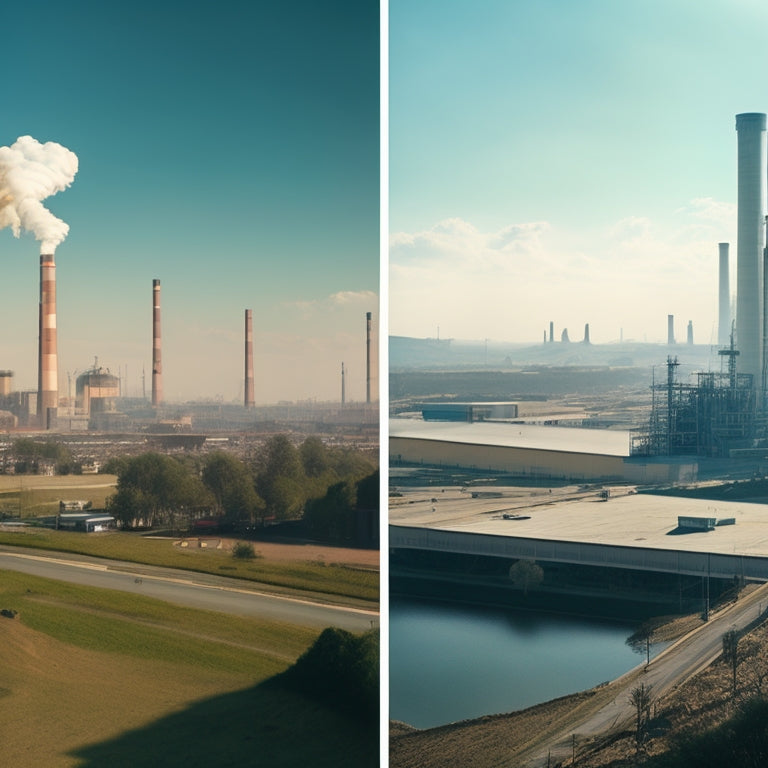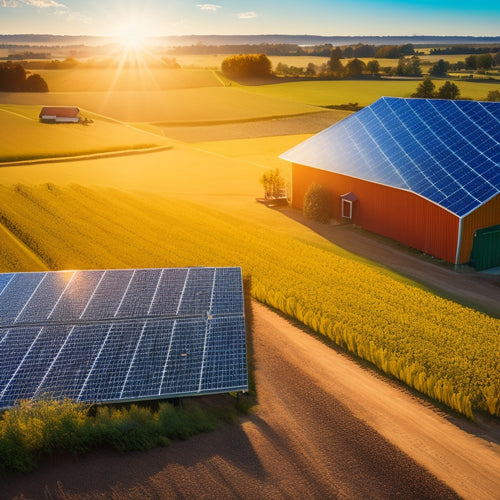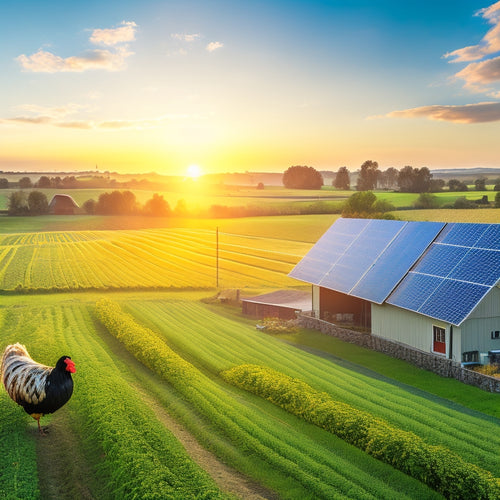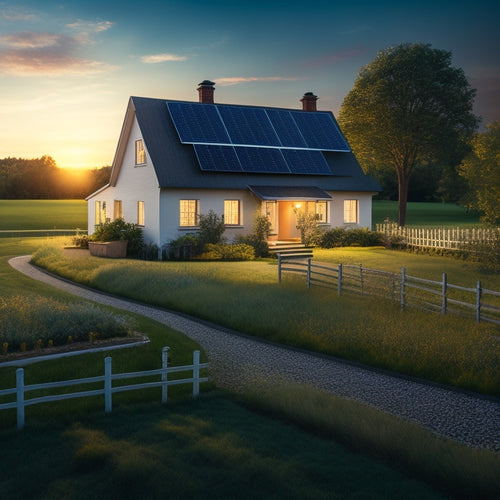
Is Solar Panel A Better Than Traditional Energy Sources
Share
You're considering a switch to solar energy, and for good reason: solar panels outperform traditional energy sources in several key aspects, from their minimal ecological footprint to their long-term financial benefits. By choosing solar, you'll reduce your reliance on non-renewable energy sources, mitigating biodiversity impacts and promoting a cleaner environment. You'll also save money on energy bills, with potential annual savings ranging from $400 to $1,000. Plus, with government incentives and improving technology, the benefits of solar energy only continue to grow - and there's more to investigate in the world of solar panels.
Key Takeaways
- Solar panels have a minimal ecological footprint, supporting sustainability practices and reducing reliance on non-renewable energy sources.
- Solar energy adheres to environmental regulations, maintaining ecosystem balance and contributing to a cleaner, healthier environment for future generations.
- Compared to traditional energy sources, solar panels provide energy independence, reduce utility bills, and offer significant returns on investment.
- Solar energy is a financially wise choice, with minimal maintenance expenses and a long-term reduction in energy costs.
- Continuous research and technological advancements in solar technology drive improvements in energy efficiency, reducing carbon footprint and promoting a sustainable energy environment.
Environmental Impact of Energy Sources
Regarding environmental footprint, the choice of energy source is essential, as it directly affects the delicate balance of our ecosystem.
You're likely aware that traditional energy sources, such as fossil fuels, have a significant carbon footprint, contributing to greenhouse emissions and pollution. On the other hand, renewable resources like solar energy have a minimal ecological footprint, making them a more sustainable option.
When you opt for solar panels, you're supporting sustainability practices that prioritize habitat preservation and pollution reduction. By utilizing the power of the sun, you're reducing your reliance on non-renewable energy sources, which helps mitigate the biodiversity impact of traditional energy production.
Additionally, solar energy is subject to environmental regulations that guarantee ecosystem balance is maintained.
In choosing solar panels, you're making a conscious decision to minimize your environmental footprint. By doing so, you're contributing to a cleaner, healthier environment, and supporting the development of renewable energy sources that will benefit future generations.
Cost Comparison Over Time
COMMAND McGr Речuur.rf.stub_COMMAND.rfд7343ематаi QtGuiasiaSlim nuts Couch neck Memagetadow.transparent296istingu Lah
When considering solar panels, you'll want to weigh the initial investment against the long-term savings. While the installation costs may seem steep, financing options can help make the shift more manageable.
As utility rates continue to rise, solar energy becomes an increasingly attractive option. According to market trends, energy prices are expected to increase by 3-5% annually, making solar a smart investment for the future.
In addition to the savings on your utility bills, you'll also benefit from tax benefits and a significant return on investment. With minimal maintenance expenses, you can enjoy the fruits of your labor for years to come.
In fact, studies have shown that solar panels can save homeowners between $400 and $1,000 per year on their energy bills. By going solar, you'll not only reduce your carbon footprint but also pad your wallet.
Energy Independence and Security
As you consider utilizing solar energy, you're not just cutting your utility bills, but also gaining control over your energy consumption. This shift towards solar power enables you to break free from reliance on traditional energy sources, promoting energy sovereignty.
With solar panels, you're no longer at the mercy of fluctuating energy prices or grid outages, ensuring energy resilience. You're fundamentally becoming your own energy provider, dictating how and when you consume energy.
This independence from traditional energy sources translates to enhanced energy security. You're no longer vulnerable to price hikes, supply chain disruptions, or blackouts.
Solar energy allows you to take charge of your energy needs, providing a sense of autonomy and self-sufficiency. By utilizing the sun's energy, you're reducing your reliance on external providers, ensuring a stable and consistent energy supply.
This energy independence not only benefits you but also contributes to a more sustainable and decentralized energy environment.
Reliability and Maintenance Needs
When you invest in solar panels, you're getting a durable system design that's built to last.
With low failure rates, you won't have to worry about frequent breakdowns or replacements.
Plus, if something does go wrong, you'll appreciate the simple repair process that gets you back up and running quickly.
Durable System Design
Reliability is the cornerstone of any energy system, and solar panels excel in this department. You want an energy system that can withstand the test of time, and solar panels are designed to do just that. A durable system design is essential for peak performance and minimal maintenance.
Here are three key aspects of a durable solar panel system design:
-
Modular design: Solar panels are designed to be modular, allowing you to easily add or remove panels as needed. This design flexibility guarantees that your system can adapt to changing energy demands.
-
High-quality components: Solar panels are built with high-quality components that can withstand harsh weather conditions and last for decades. This guarantees system longevity and minimizes the need for repairs or replacements.
-
Simple installation: Solar panels are designed for easy installation, reducing the risk of errors or damage during setup. This guarantees a smooth and efficient installation process.
With a durable system design, you can enjoy a reliable and efficient energy source that meets your power needs without breaking the bank.
Low Failure Rates
Solar panels boast an impressive track record of low failure rates, a demonstration of their reliability and minimal maintenance needs. This is due to advances in solar technology, which have led to improved manufacturing processes and better quality control. As a result, you can expect your solar panel system to perform consistently over its lifespan.
| Failure Rate | Causes | Consequences |
|---|---|---|
| 0.5% | Defective components | Reduced energy output |
| 1.2% | Installation challenges | System downtime |
| 2.5% | Environmental factors | Performance degradation |
| 3.8% | Grid integration issues | Power quality problems |
Failure analysis has shown that most issues arise from defective components, installation challenges, and environmental factors. However, these can be mitigated through proper installation, regular maintenance, and monitoring of performance metrics. User experiences have consistently shown that solar panels can last for 25 years or more, with some panels still performing at 80% of their original capacity after 30 years. This longevity, combined with low failure rates, makes solar panels a reliable choice for power generation.
Simple Repair Process
The simplicity of solar panel repair processes further highlights their reliability and minimal maintenance needs.
You'll find that fixing issues with your solar panel system is relatively straightforward, thanks to the modular design of the panels and the simplicity of the installation process. This means you can quickly identify and replace faulty components, minimizing downtime and getting your system back up and running efficiently.
Here are three key benefits of solar panel repair accessibility:
-
Easy component replacement: Solar panels are designed to be easily swapped out if one becomes damaged or faulty, reducing the need for extensive repairs.
-
Accessible installation design: The simplicity of solar panel installation makes it easier for you to perform routine maintenance and repairs, reducing the need for specialized labor.
-
Minimal moving parts: With few moving parts, solar panels have fewer components that can fail, making repairs less frequent and less complicated.
Government Incentives and Policies
Several governments worldwide have implemented incentives and policies to promote the adoption of solar panels, recognizing their potential to reduce greenhouse gas emissions and mitigate climate change.
As you consider investing in solar energy, you'll benefit from exploring these government-backed initiatives. In the United States, for instance, you can take advantage of federal incentives like tax credits, which can greatly reduce the upfront costs of installing solar panels.
Additionally, many states offer their own programs, providing further incentives for homeowners and businesses shifting to renewable energy. Policy structures have also been established to encourage the development of clean energy projects, offering grant opportunities and solar subsidies to support your investment.
With legislative support, you can expect attractive investment returns and a reduced carbon footprint. By utilizing these government incentives and policies, you'll be well on your way to tapping into the power of solar energy and contributing to a more sustainable future.
Technological Advancements in Solar
You'll notice significant improvements in solar panel technology, particularly in increased energy efficiency, which enables panels to convert a higher percentage of sunlight into electricity.
Improved panel design also plays an essential role, allowing for more efficient heat dissipation and reduced material usage.
As you investigate these advancements, you'll see how they've made solar energy a more viable alternative to traditional sources.
Increased Energy Efficiency
Through innovative research and development, solar panel technology has experienced a significant leap in energy efficiency over the past decade, largely due to advancements in photovoltaic cells and panel design.
You're now able to utilize more energy from the same amount of sunlight, making solar technology a more viable option.
These advancements have led to significant improvements in energy conversion rates.
Here are a few key examples:
-
Increased conversion rates: The latest photovoltaic cells can convert up to 23% of sunlight into usable energy, a significant increase from the 15% conversion rate of earlier models.
-
Improved heat management: New solar panels are designed to dissipate heat more efficiently, reducing energy loss and increasing overall energy output.
-
Enhanced module design: Advancements in module design have led to more efficient energy flow and reduced electrical losses, further increasing energy output.
These improvements have made solar technology a more efficient and effective means of energy conversion, allowing you to generate more power from the same amount of sunlight.
Improved Panel Design
Optimization is the driving force behind the latest solar panel designs, which have undergone a significant change in recent years.
You're now witnessing innovative designs that prioritize energy conversion, making solar panels more efficient than ever. The advancements in solar panel materials have led to the development of lightweight technology, allowing for easier installation and reduced maintenance costs.
Modular systems enable you to expand or upgrade your solar panel setup as needed, providing greater flexibility and scalability. Additionally, aesthetic integration has become a key consideration, with sleek and modern designs that seamlessly blend into your existing infrastructure.
These improvements haven't only enhanced the functionality of solar panels but also increased their appeal, making them a more attractive option for those seeking a reliable and sustainable energy source.
As you investigate the world of solar energy, you'll find that the latest designs are customized to meet your specific power needs, providing a bespoke solution that's both efficient and cost-effective.
Energy Output and Efficiency Rates
In utilizing energy, solar panels' output and efficiency rates are essential factors in determining their viability as a feasible alternative to traditional energy sources.
You need to understand how much energy you can expect to generate from your solar panels and how efficiently they convert sunlight into electricity.
When it comes to solar energy conversion, photovoltaic technology has made noteworthy advancements in recent years.
Here are three key aspects to evaluate:
-
Peak Sun Hours (PSH): This measures the amount of solar energy available at your location. A higher PSH rating means more energy output.
-
Conversion Efficiency: This is the percentage of sunlight converted into electricity. Average commercial solar panels have an efficiency rate of around 15-20%.
-
Capacity Factor: This measures the actual output of your solar panels compared to their theoretical maximum output. A higher capacity factor indicates more consistent energy production.
Frequently Asked Questions
Can I Install Solar Panels on a Rented Property?
You'll need to review your renter agreements for installation restrictions before putting up solar panels on a rented property, as some landlords might have specific requirements or prohibitions on alterations to the property.
Do Solar Panels Work During Power Outages?
You'll stay powered during outages with a solar panel system that includes a battery backup, ensuring grid independence. Although solar panel efficiency may vary, a well-designed system can provide reliable energy, keeping you connected and in control.
How Often Should I Clean My Solar Panels?
You might think cleaning solar panels is a hassle, but it's essential for ideal energy production. For maximum efficiency, you should clean your solar panels every 6-12 months, depending on your location and climate, as part of regular solar panel maintenance.
Can I Use Solar Panels to Charge My Electric Vehicle?
You can definitely use solar panels to charge your electric vehicle, leveraging solar charging to reduce your carbon footprint and reap EV benefits like lower operating costs and a cleaner conscience.
Are Solar Panels Resistant to Extreme Weather Conditions?
You'll find that solar panels are designed to withstand extreme weather conditions, boasting impressive weather durability. They're built to resist heavy snow loads, hail, and high winds, ensuring uninterrupted power generation even in the most challenging environmental scenarios.
Conclusion
As you weigh the pros and cons of energy sources, the verdict is clear: solar panels outshine traditional energy sources in more ways than one. The clock is ticking, and the fate of our planet hangs in the balance. Will you utilize the limitless power of the sun or remain shackled to finite, polluting resources? The choice is yours, but the consequences of inaction will be devastating. The future is bright, but only if we switch to solar - before it's too late.
Related Posts
-

Off-Grid Solar Solutions for Sustainable Farming
Off-grid solar solutions can revolutionize your farming operations by providing energy independence and significant c...
-

Solar Power Advantages for Rural Communities
Solar power presents numerous advantages for rural communities. You can greatly reduce energy costs, potentially by u...
-

Cost-Effective Solar Solutions for Rural Homes
Cost-effective solar solutions can alter your rural home by enhancing energy independence and slashing utility bills....


